Design Optimization of a Grid-Tied Hybrid System for a Department at a University with a Dispatch Strategy-Based Assessment
Abstract
1. Introduction
- First, figure out the best configuration and optimal dimensions for the hybrid grid-connected microgrid components based on renewable energy, such as converters, solar PVs, wind turbines, etc., using a derivative-free technique. This will ensure that the net present cost (NC) and levelized cost of energy (LE) of the different options are as low as possible in the selected locations.
- Second, by investigating the electrical performance of the system (active power, current, frequency, and voltage fluctuations of the developed microgrid) using the DIgSILENT PowerFactory structure, the best possible, cost-effective, stable, and dependable functioning of the optimum microgrid layout (based on the results obtained in the prior step) is guaranteed. In the future, the simulated results can be realistically used for the development of microgrids in real life.
2. Demonstration of the Grid-Connected Microgrid System
2.1. Proposed Location
2.2. Information on Load Demand
2.3. Summary of the Resources
2.4. Construction of the Prototype of the Proposed Microgrid
3. Methodological Approach of the Research Work
- Real field component costs (gathered from market analysis) and meteorological resource data (wind speed and sunlight radiation data) were employed for the purpose of optimal size assessments.
- The suggested system’s ability to produce stable and practicable responses was determined by analyzing the microgrid power system responses using the DIgSILENT PowerFactory platform with the appropriate system model. This ensured that the designed microgrid operated steadily and reliably.
3.1. Load-Following (LoF) DiS
3.2. Cycle-Charging (CyC) DiS
3.3. Problem Formulation
3.3.1. Objective Function
3.3.2. Equality and Inequality Constraints
Active Power Balance Constraint
Generation Constraints
3.3.3. Optimal Sizing and Cost Function Reduction
3.3.4. Formulation of LE Calculation
Formulation of NC Calculation
Formulation of CO2 Emission
Formulation of Economic Dispatch
Formulation of Frequency Stabilization
4. Result and Discussion
4.1. Technoeconomic Analysis
4.2. Power System Assessment
System’s Frequency Response
4.3. Voltage Responses of the Microgrid Components
4.4. Current Responses
4.5. Active Power Responses
4.6. Discussion of the Result
4.7. Application of the Research Work
5. Conclusions
Author Contributions
Funding
Institutional Review Board Statement
Informed Consent Statement
Data Availability Statement
Acknowledgments
Conflicts of Interest
References
- Ishraque, M.F.; Shezan, S.A.; Ali, M.; Rashid, M. Optimization of load dispatch strategies for an islanded microgrid connected with renewable energy sources. Appl. Energy 2021, 292, 116879. [Google Scholar] [CrossRef]
- Wang, J.; Azam, W. Natural resource scarcity, fossil fuel energy consumption, and total greenhouse gas emissions in top emitting countries. Geosci. Front. 2024, 15, 101757. [Google Scholar] [CrossRef]
- Chen, X.; Zhang, M.; Jiang, S.; Gou, H.; Zhou, P.; Yang, R.; Shen, B. Energy reliability enhancement of a data center/wind hybrid DC network using superconducting magnetic energy storage. Energy 2023, 263, 125622. [Google Scholar] [CrossRef]
- Abo-Zahhad, E.M.; Rashwan, A.; Salameh, T.; Hamid, A.K.; Faragalla, A.; El-Dein, A.Z.; Chen, Y.; Abdelhameed, E.H. Evaluation of solar PV-based microgrids viability utilizing single and multi-criteria decision analysis. Renew. Energy 2024, 221, 119713. [Google Scholar] [CrossRef]
- Rad, M.A.V.; Kasaeian, A.; Mahian, O. Evaluation of stand-alone hybrid renewable energy system with excess electricity minimizer predictive dispatch strategy. Energy Convers. Manag. 2024, 299, 117898. [Google Scholar]
- Cortes, G.S.; Gao, G.P.; Silva, F.B.; Song, Z. Unconventional monetary policy and disaster risk: Evidence from the subprime and COVID–19 crises. J. Int. Money Financ. 2022, 122, 102543. [Google Scholar] [CrossRef]
- Zurita, A.; Mata-Torres, C.; Cardemil, J.M.; Guédez, R.; Escobar, R.A. Multi-objective optimal design of solar power plants with storage systems according to dispatch strategy. Energy 2021, 237, 121627. [Google Scholar] [CrossRef]
- Chaurasia, R.; Gairola, S.; Pal, Y. Technical, economic feasibility and sensitivity analysis of solar photovoltaic/battery energy storage off-grid integrated renewable energy system. Energy Storage 2022, 4, e283. [Google Scholar] [CrossRef]
- Aziz, A.S.; Tajuddin, M.F.N.; Adzman, M.R.; Azmi, A.; Ramli, M.A. Optimization and sensitivity analysis of standalone hybrid energy systems for rural electrification: A case study of Iraq. Renew. Energy 2019, 138, 775–792. [Google Scholar] [CrossRef]
- Ali, F.; Ahmar, M.; Jiang, Y.; AlAhmad, M. A techno-economic assessment of hybrid energy systems in rural Pakistan. Energy 2021, 215, 119103. [Google Scholar] [CrossRef]
- Beza, T.M.; Wu, C.H.; Kuo, C.C. Optimal sizing and techno-economic analysis of minigrid hybrid renewable energy system for tourist destination islands of Lake Tana, Ethiopia. Appl. Sci. 2021, 11, 7085. [Google Scholar] [CrossRef]
- Heydari, A.; Nezhad, M.M.; Keynia, F.; Fekih, A.; Shahsavari-Pour, N.; Garcia, D.A.; Piras, G. A combined multi-objective intelligent optimization approach considering techno-economic and reliability factors for hybrid-renewable microgrid systems. J. Clean. Prod. 2023, 383, 135249. [Google Scholar] [CrossRef]
- Elazab, R.; Abdelnaby, A.T.; Keshta, H.; Ali, A. Optimal techno-economic feasibility analysis of a grid-tied microgrid considering demand response strategy. Electr. Power Syst. Res. 2023, 224, 109768. [Google Scholar] [CrossRef]
- Shahbazbegian, V.; Dehghani, F.; Shafiyi, M.A.; Shafie-khah, M.; Laaksonen, H.; Ameli, H. Techno-economic assessment of energy storage systems in multi-energy microgrids utilizing decomposition methodology. Energy 2023, 283, 128430. [Google Scholar] [CrossRef]
- Bouendeu, J.J.; Konchou, F.A.T.; Astrid, M.N.B.; Elmorshedy, M.F.; René, T. A systematic techno-enviro-socio-economic design optimization and power quality of hybrid renewable microgrids. Renew. Energy 2023, 218, 119297. [Google Scholar] [CrossRef]
- Abid, M.S.; Ahshan, R.; Al Abri, R.; Al-Badi, A.; Albadi, M. Techno-economic and environmental assessment of renewable energy sources, virtual synchronous generators, and electric vehicle charging stations in microgrids. Appl. Energy 2024, 353, 122028. [Google Scholar] [CrossRef]
- Elkholy, M.; Said, T.; Elymany, M.; Senjyu, T.; Gamil, M.M.; Song, D.; Ueda, S.; Lotfy, M.E. Techno-economic configuration of a hybrid backup system within a microgrid considering vehicle-to-grid technology: A case study of a remote area. Energy Convers. Manag. 2024, 301, 118032. [Google Scholar] [CrossRef]
- Ram, K.; Chand, S.S.; Prasad, R.; Mohammadi, A.; Cirrincione, M. Microgrids for green hydrogen production for fuel cell buses–A techno-economic analysis for Fiji. Energy Convers. Manag. 2024, 300, 117928. [Google Scholar] [CrossRef]
- Wong, S.Y.; Li, C. Techno-economic analysis of optimal hybrid renewable energy systems—A case study for a campus microgrid. Energy Rep. 2023, 9, 134–138. [Google Scholar] [CrossRef]
- Alluraiah, N.C.; Vijayapriya, P. Optimization, design and feasibility analysis of a grid-integrated hybrid AC/DC microgrid system for rural electrification. IEEE Access 2023, 11, 67013–67029. [Google Scholar] [CrossRef]
- Chakraborty, A.; Ray, S. Economic and environmental factors based multi-objective approach for optimizing energy management in a microgrid. Renew. Energy 2024, 222, 119920. [Google Scholar] [CrossRef]
- Khan, M.A.; Bayati, N.; Ebel, T. Techno-economic analysis and predictive operation of a power-to-hydrogen for renewable microgrids. Energy Convers. Manag. 2023, 298, 117762. [Google Scholar] [CrossRef]
- Parvin, M.; Yousefi, H.; Noorollahi, Y. Techno-economic optimization of a renewable micro grid using multi-objective particle swarm optimization algorithm. Energy Convers. Manag. 2023, 277, 116639. [Google Scholar] [CrossRef]
- Liu, W.; Zhuang, P.; Liang, H.; Peng, J.; Huang, Z. Distributed economic dispatch in microgrids based on cooperative reinforcement learning. IEEE Trans. Neural Netw. Learn. Syst. 2018, 29, 2192–2203. [Google Scholar] [CrossRef] [PubMed]
- Zhou, Q.; Shahidehpour, M.; Li, Z.; Che, L.; Alabdulwahab, A.; Abusorrah, A. Compartmentalization strategy for the optimal economic operation of a hybrid AC/DC microgrid. IEEE Trans. Power Syst. 2019, 35, 1294–1304. [Google Scholar] [CrossRef]
- Xiong, G.; Shi, D.; Duan, X. Multi-strategy ensemble biogeography-based optimization for economic dispatch problems. Appl. Energy 2013, 111, 801–811. [Google Scholar] [CrossRef]
- Ishraque, M.F.; Shezan, S.A.; Rashid, M.; Bhadra, A.B.; Hossain, M.A.; Chakrabortty, R.K.; Ryan, M.J.; Fahim, S.R.; Sarker, S.K.; Das, S.K. Techno-economic and power system optimization of a renewable rich islanded microgrid considering different dispatch strategies. IEEE Access 2021, 9, 77325–77340. [Google Scholar] [CrossRef]
- Wen, Y.; Chung, C.; Liu, X.; Che, L. Microgrid dispatch with frequency-aware islanding constraints. IEEE Trans. Power Syst. 2019, 34, 2465–2468. [Google Scholar] [CrossRef]
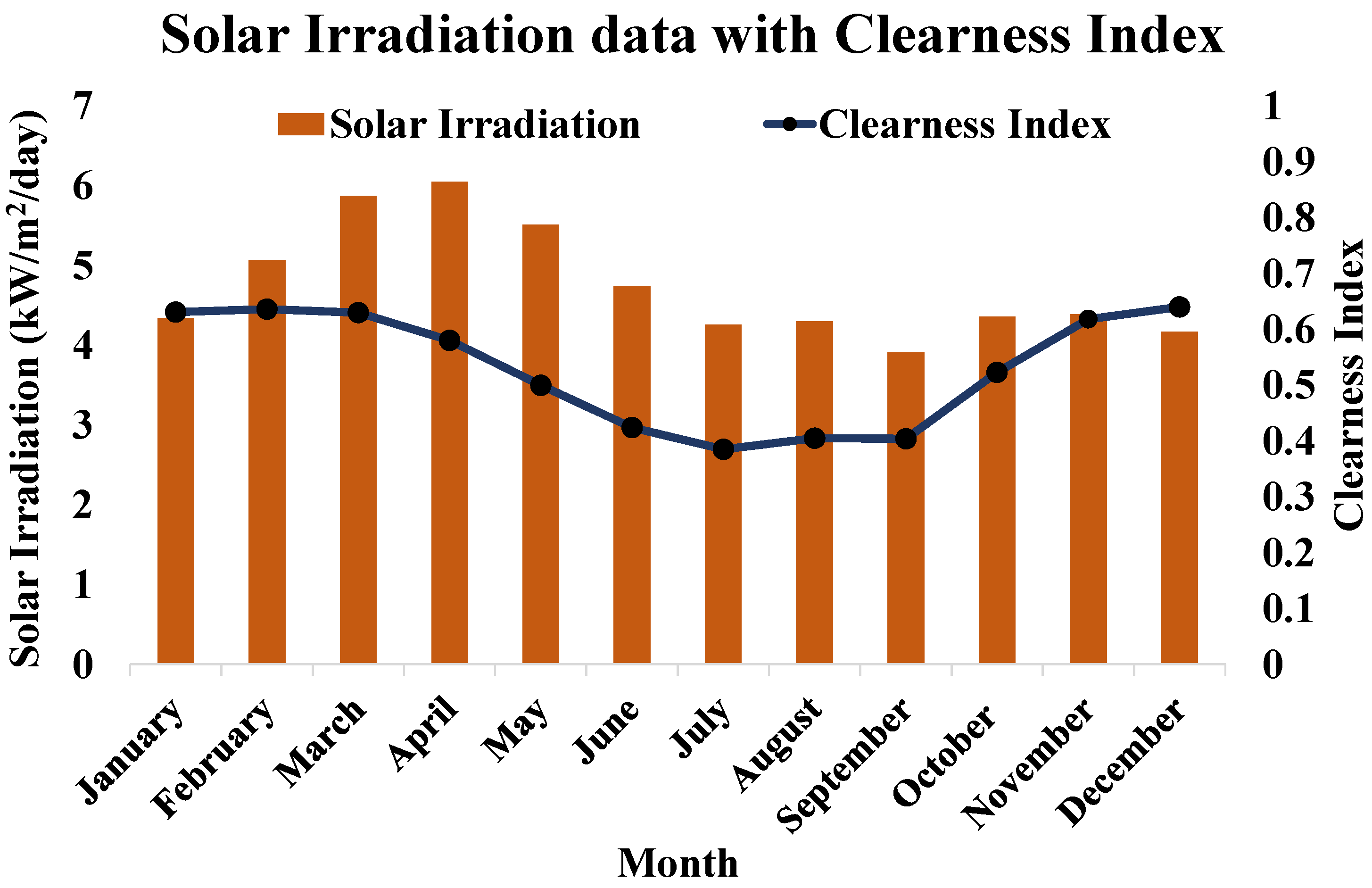
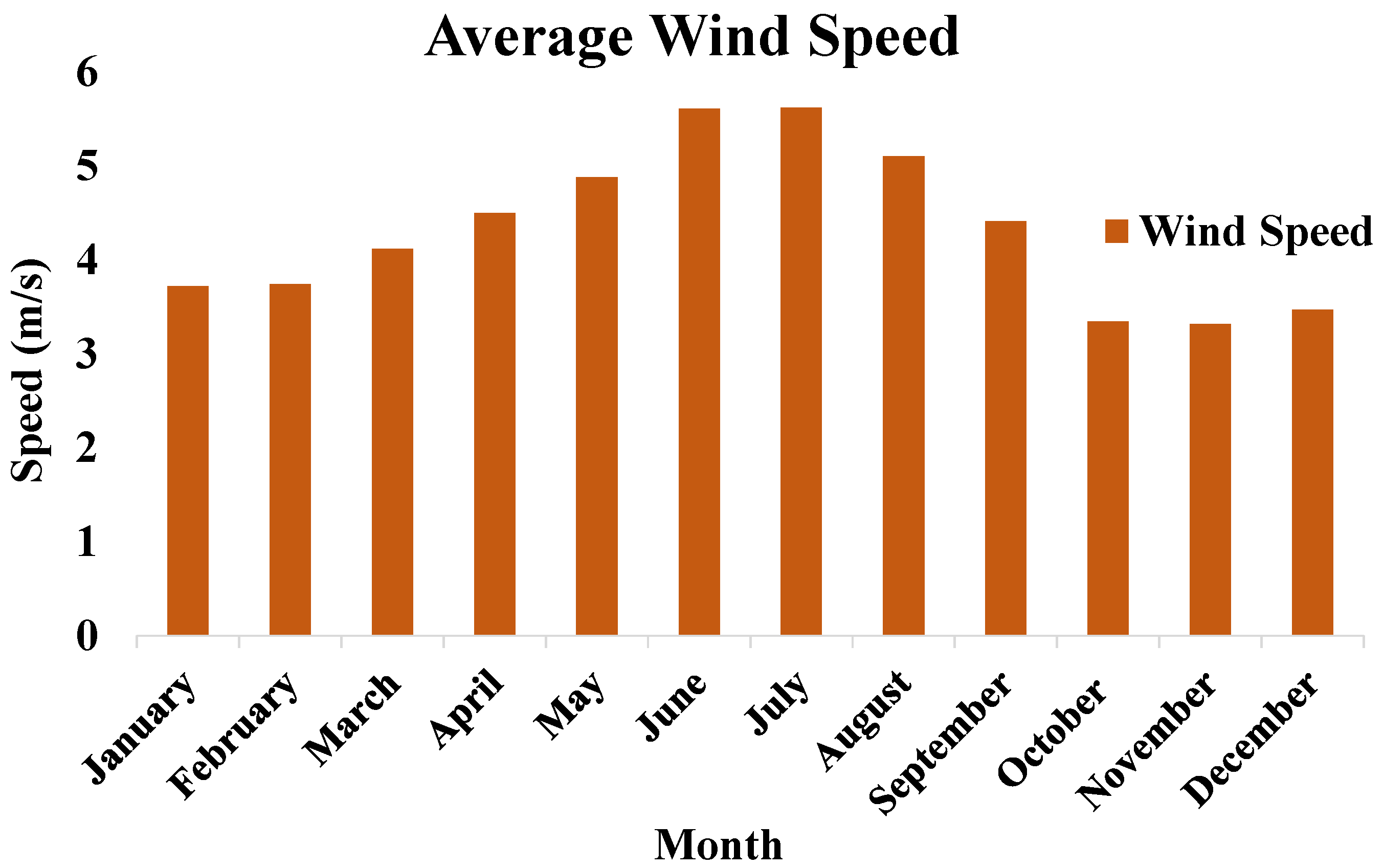
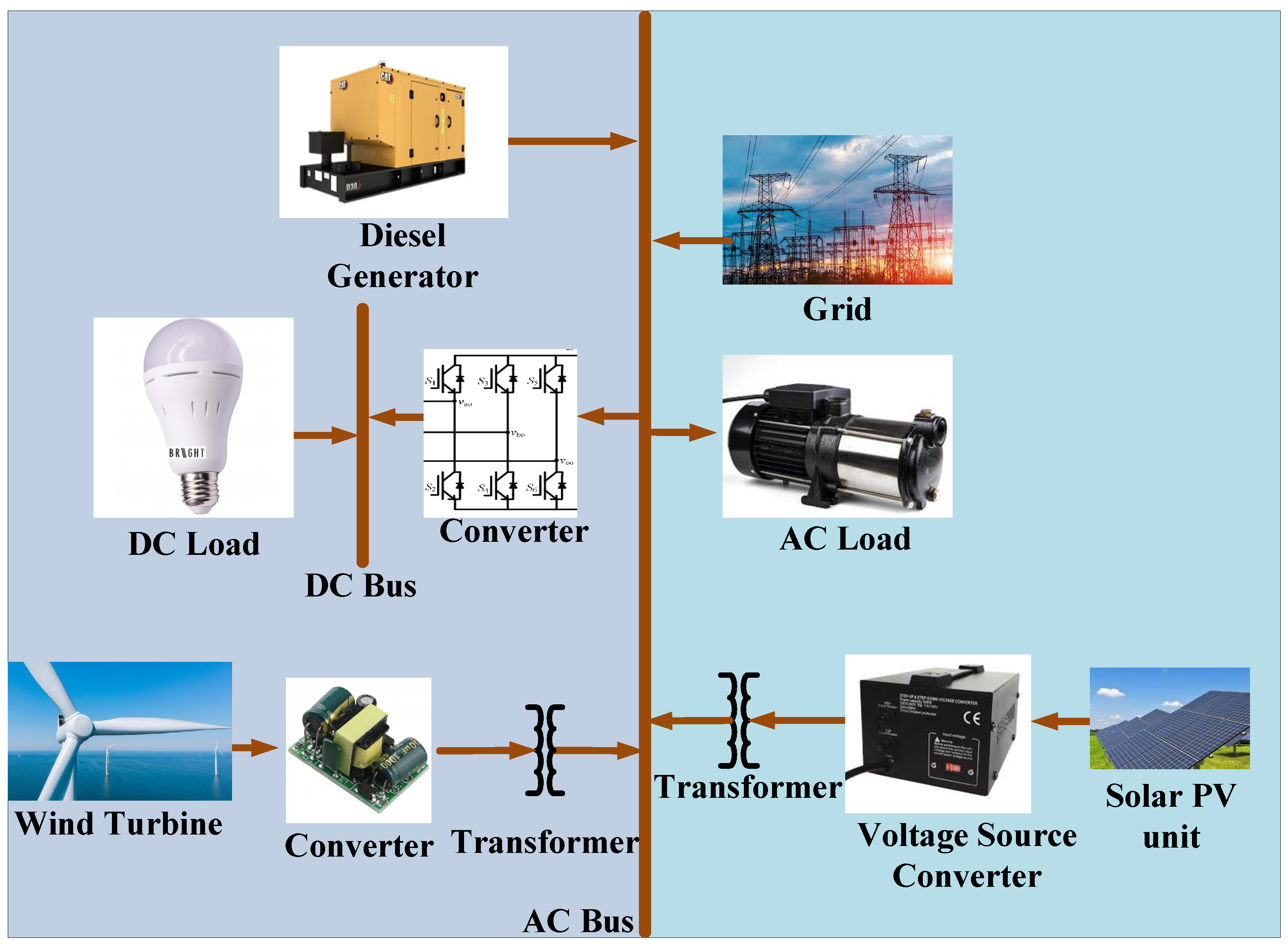
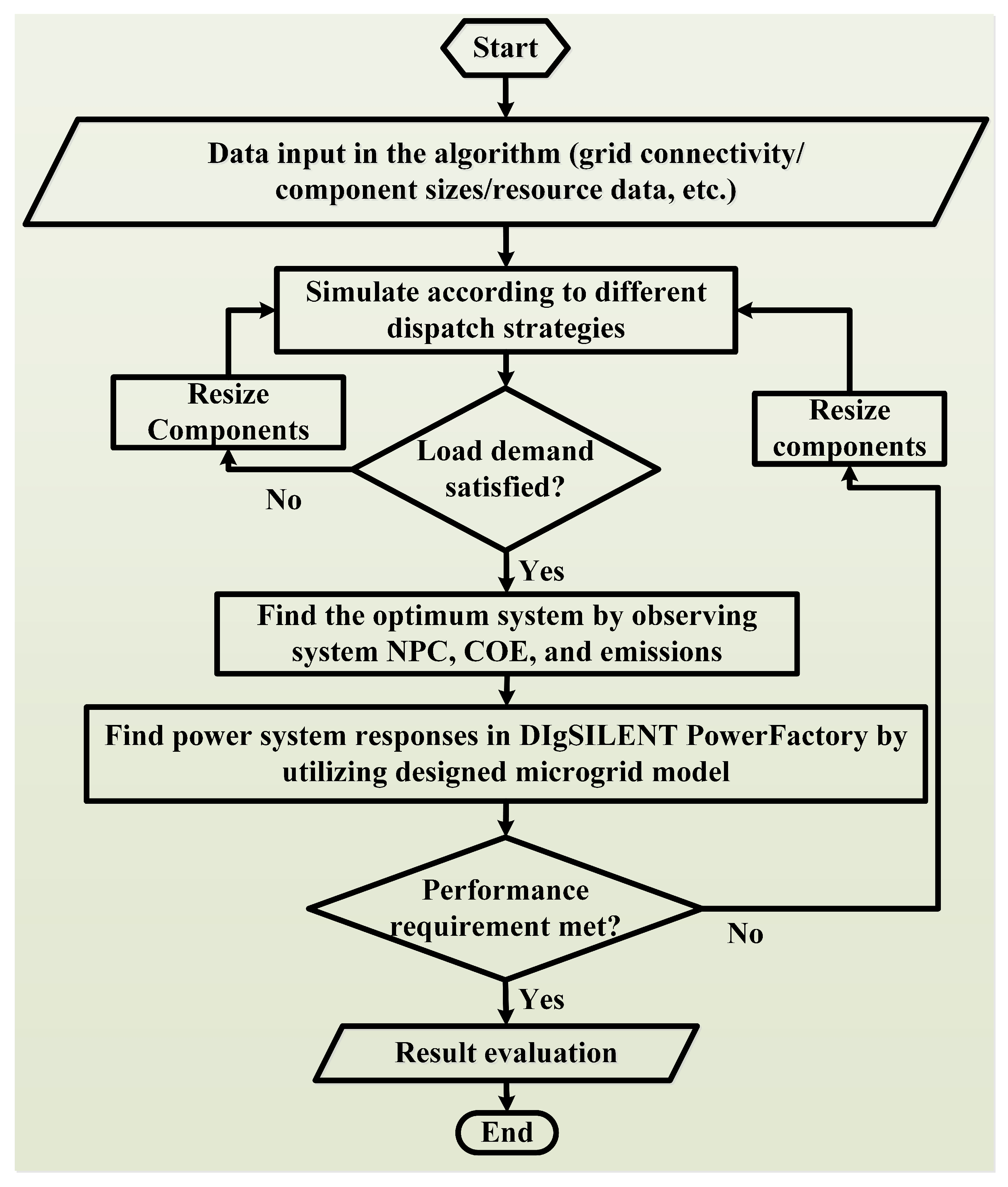
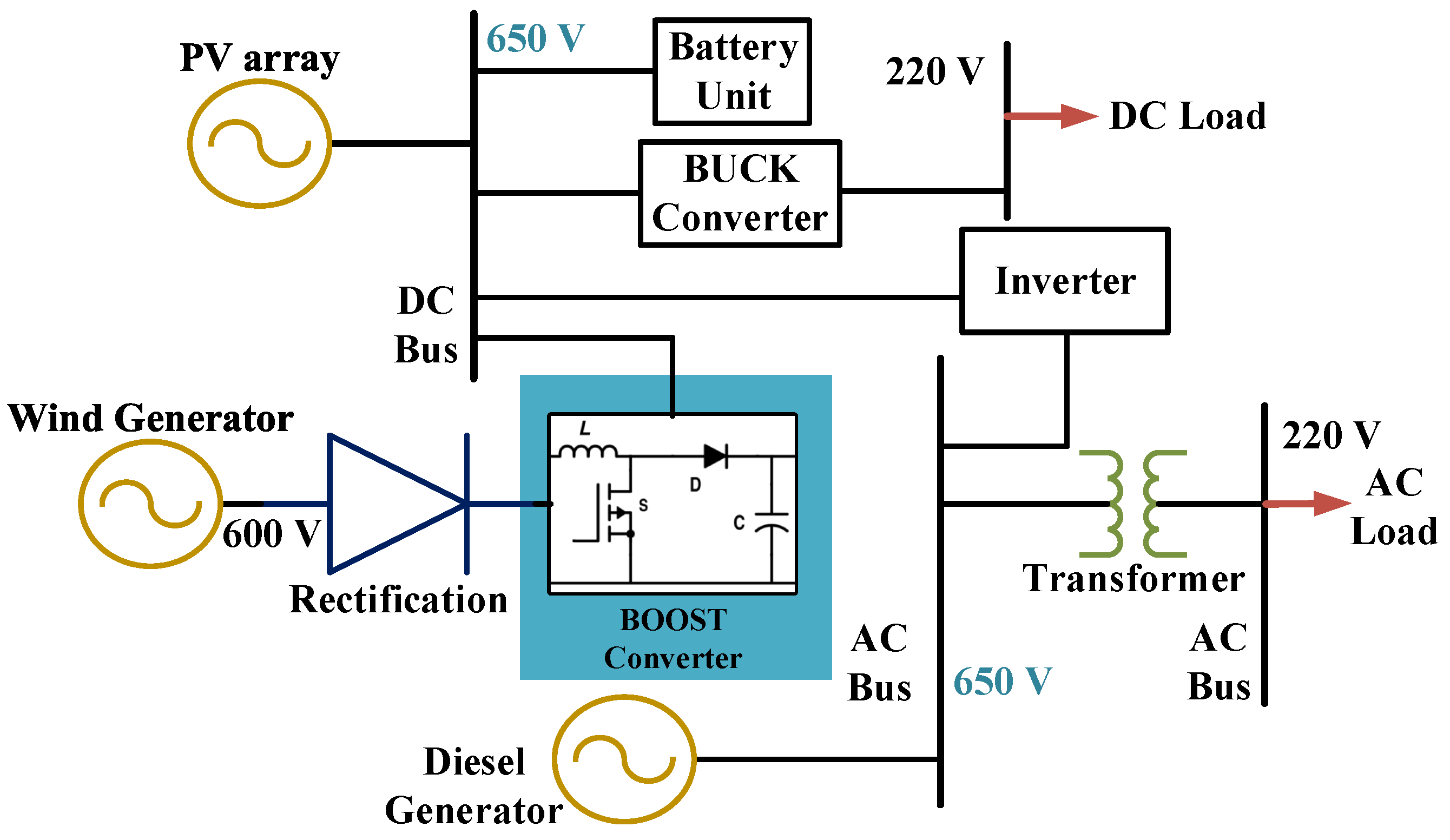
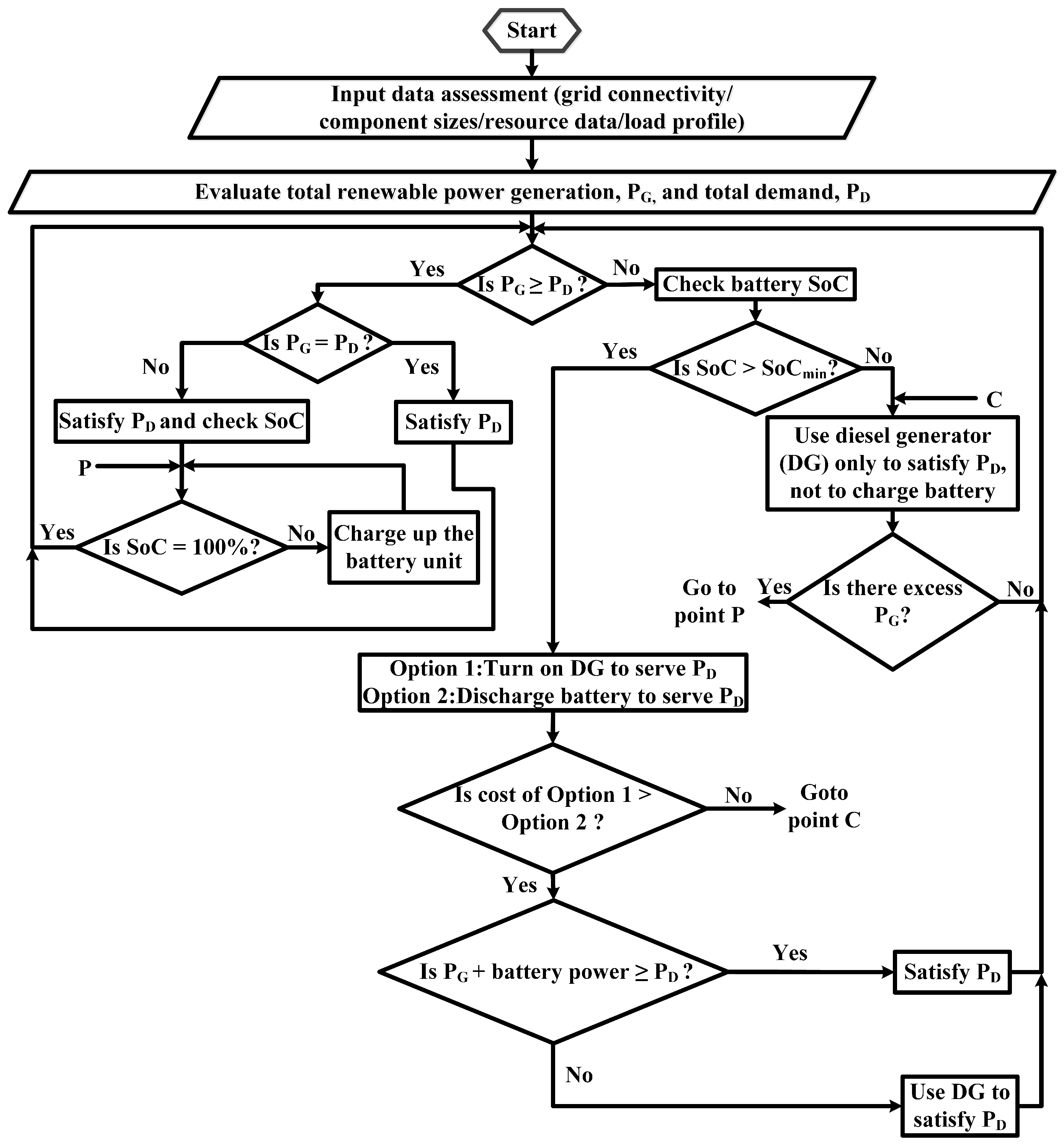
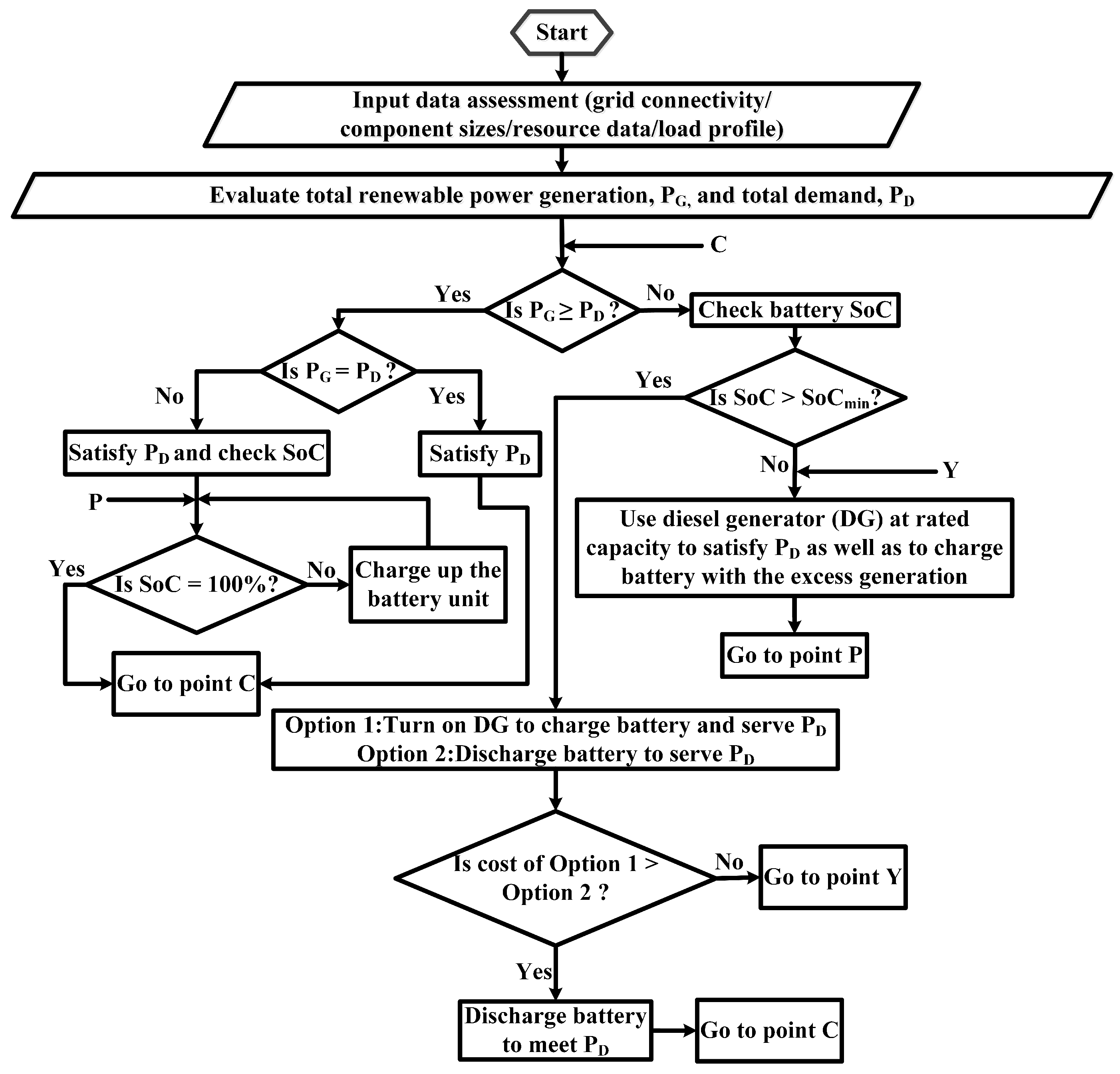
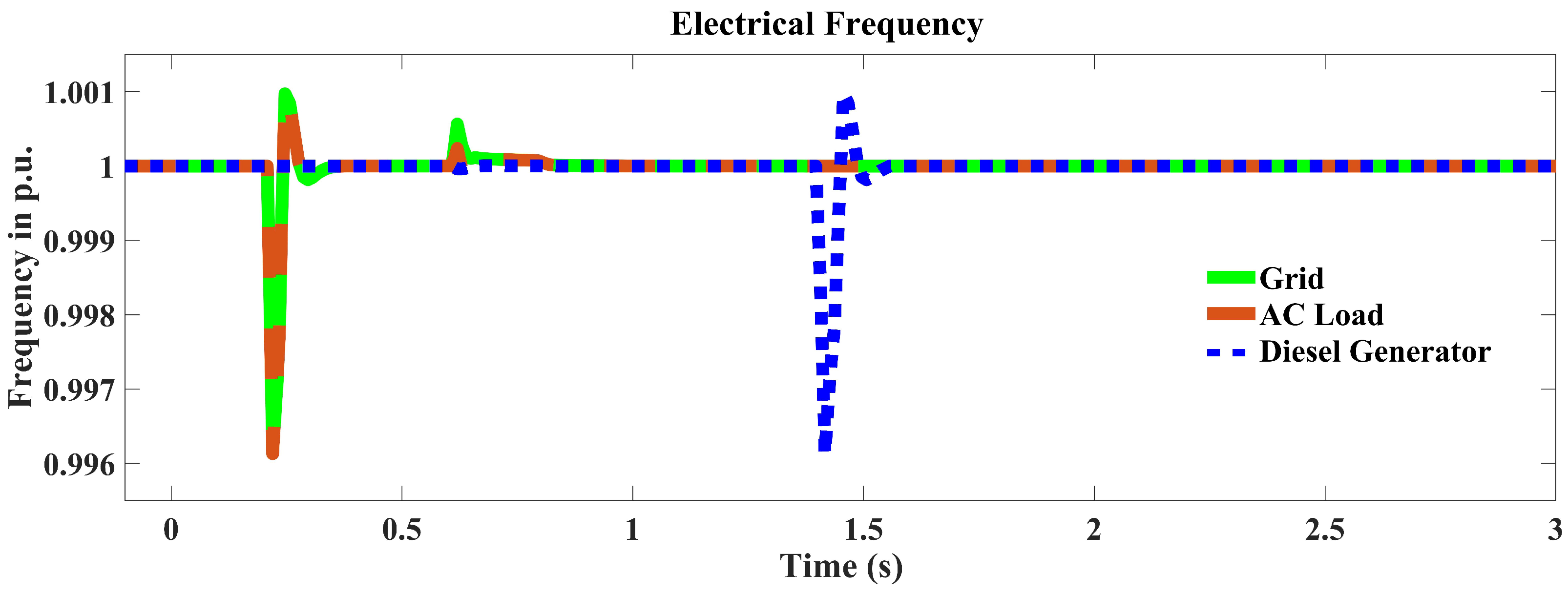
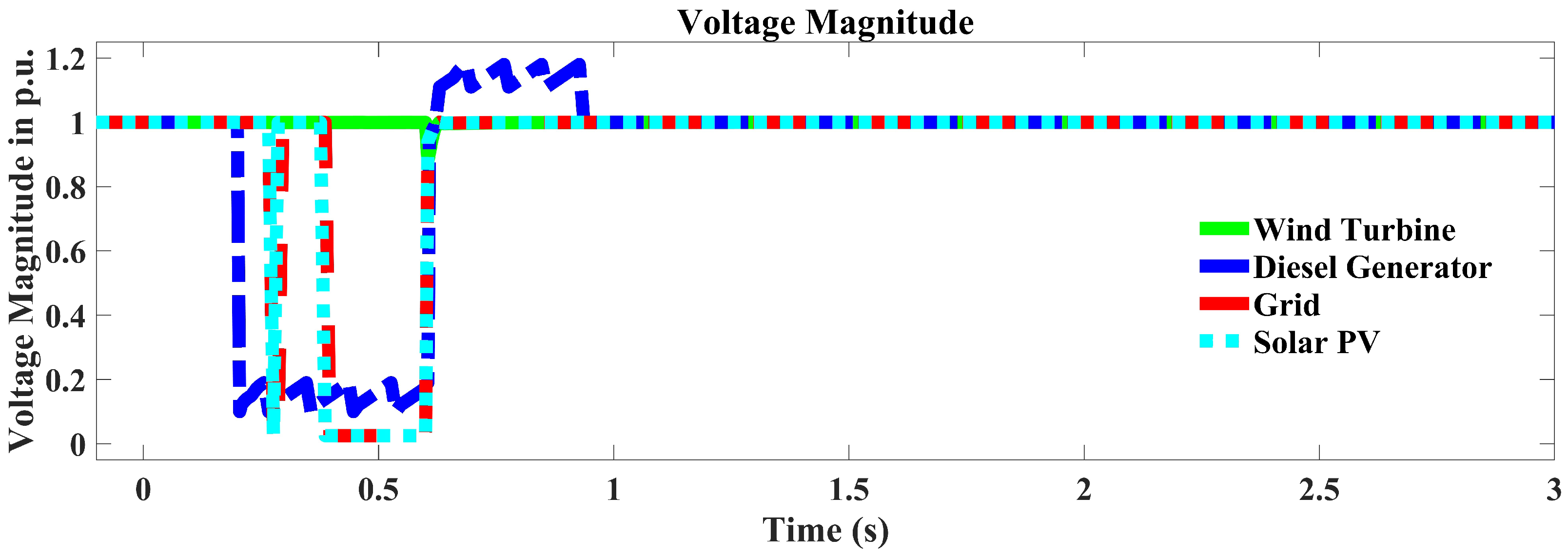

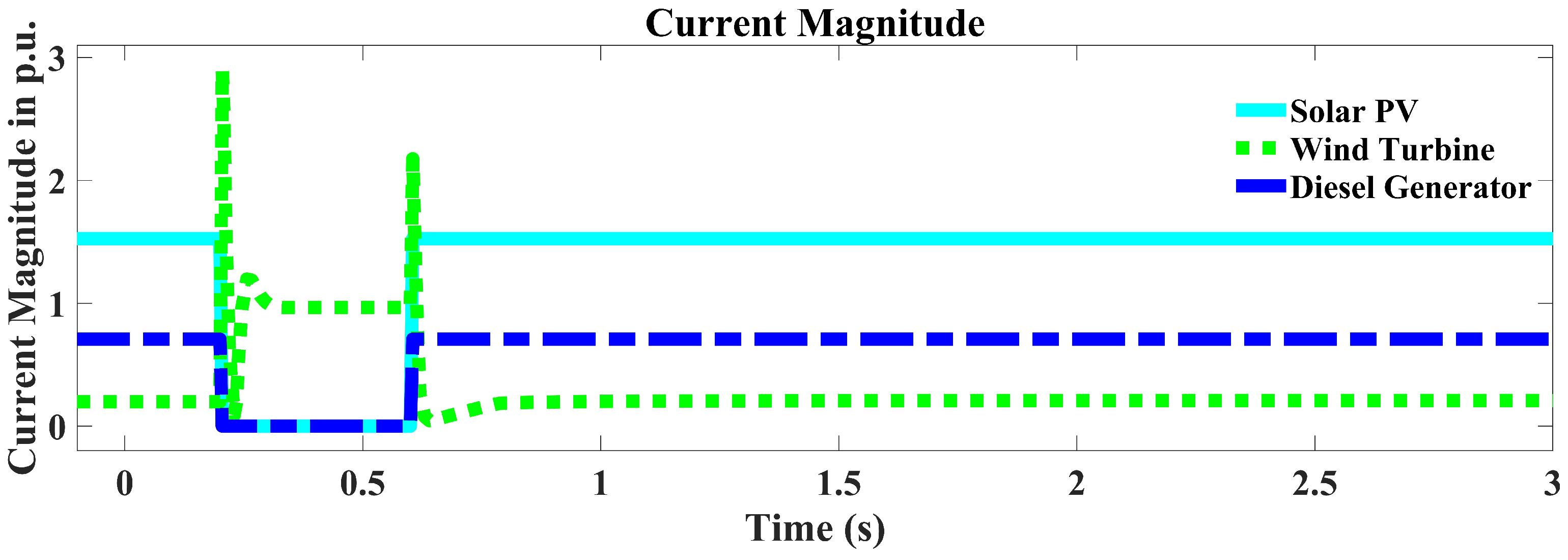
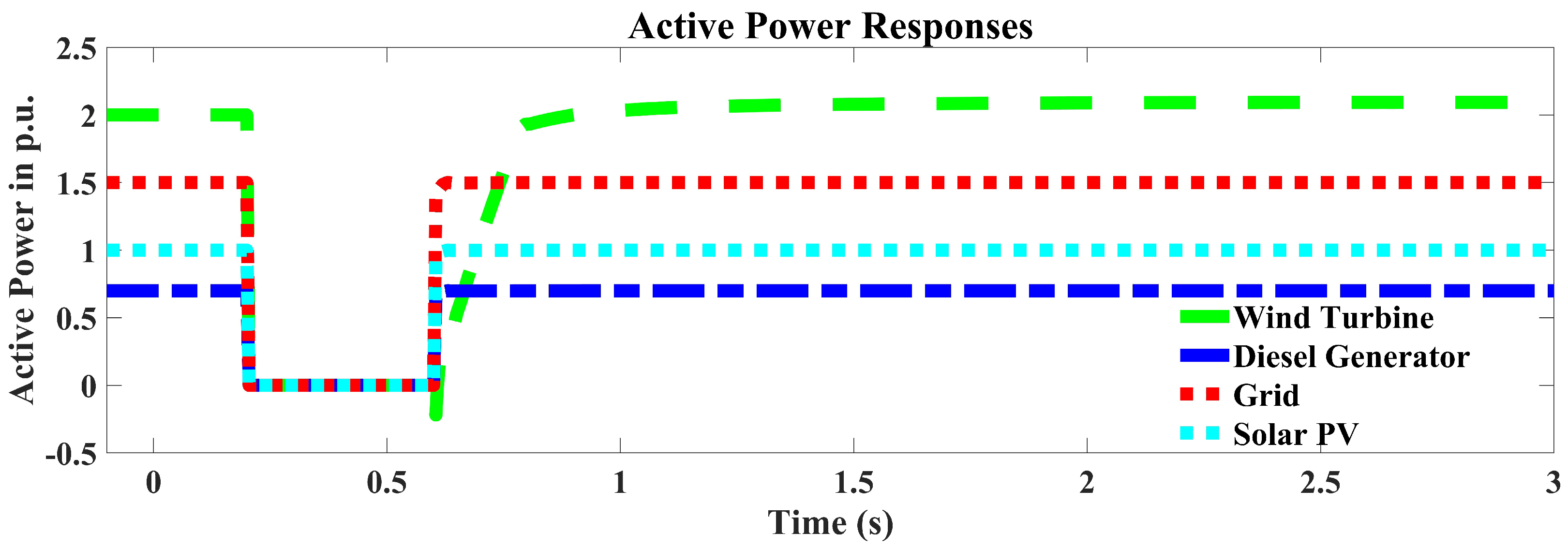
| Type of Load | No. of Units | Power Rating | Total Watt |
|---|---|---|---|
| CCTV, computer with accessories | 30 | 250 W | 7500 W |
| Ceiling fan | 30 | 100 W | 3000 W |
| Other laboratory equipment (during lab time) | - | - | 2410 W |
| Lighting load | 50 | 40 W | 2000 W |
| Air conditioner | 4 | 2000 W | 8000 W |
| Photocopy machine | 2 | 200 W | 400 W |
| Gross peak load (connected demand) | 23,310 W | ||
| DiS | Generator (kW) | PV (kW) | Battery (kWh) | Wind Turbine (kW) | Grid | Converter (kW) | LE (AUD/kWh) | NC (AUD) | Operating Cost (AUD) | |
|---|---|---|---|---|---|---|---|---|---|---|
| EnS | EnP | |||||||||
| LoF | 25 | 1.73 | 2 | 1 | 1.3 | 57,914 | 0.365 | 0.096 | 74,742 | 3814 |
| CyC | 25 | 1.73 | 2 | 1 | 1.3 | 57,914 | 0.365 | 0.096 | 74,742 | 3814 |
| Name of the Gas | CyC Quantity (kg/year) | LoF Quantity (kg/year) |
|---|---|---|
| Hydrocarbons (Unburned) | 0 | 0 |
| CO | 0 | 0 |
| CO2 | 36,602 | 36,602 |
| Oxides of N2 | 77.6 | 77.6 |
| SO2 | 159 | 159 |
| Particulate Matter | 0 | 0 |
Disclaimer/Publisher’s Note: The statements, opinions and data contained in all publications are solely those of the individual author(s) and contributor(s) and not of MDPI and/or the editor(s). MDPI and/or the editor(s) disclaim responsibility for any injury to people or property resulting from any ideas, methods, instructions or products referred to in the content. |
© 2024 by the authors. Licensee MDPI, Basel, Switzerland. This article is an open access article distributed under the terms and conditions of the Creative Commons Attribution (CC BY) license (https://creativecommons.org/licenses/by/4.0/).
Share and Cite
Ishraque, M.F.; Rahman, A.; Shezan, S.A.; Shafiullah, G.M.; Alenezi, A.H.; Hossen, M.D.; Bintu, N.E.N. Design Optimization of a Grid-Tied Hybrid System for a Department at a University with a Dispatch Strategy-Based Assessment. Sustainability 2024, 16, 2642. https://doi.org/10.3390/su16072642
Ishraque MF, Rahman A, Shezan SA, Shafiullah GM, Alenezi AH, Hossen MD, Bintu NEN. Design Optimization of a Grid-Tied Hybrid System for a Department at a University with a Dispatch Strategy-Based Assessment. Sustainability. 2024; 16(7):2642. https://doi.org/10.3390/su16072642
Chicago/Turabian StyleIshraque, Md. Fatin, Akhlaqur Rahman, Sk. A. Shezan, G. M. Shafiullah, Ali H Alenezi, Md Delwar Hossen, and Noor E Nahid Bintu. 2024. "Design Optimization of a Grid-Tied Hybrid System for a Department at a University with a Dispatch Strategy-Based Assessment" Sustainability 16, no. 7: 2642. https://doi.org/10.3390/su16072642
APA StyleIshraque, M. F., Rahman, A., Shezan, S. A., Shafiullah, G. M., Alenezi, A. H., Hossen, M. D., & Bintu, N. E. N. (2024). Design Optimization of a Grid-Tied Hybrid System for a Department at a University with a Dispatch Strategy-Based Assessment. Sustainability, 16(7), 2642. https://doi.org/10.3390/su16072642












